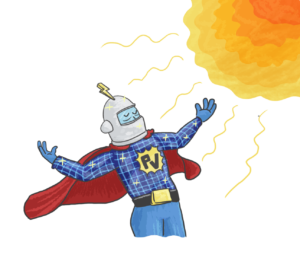Green Energy
The superheroes of the energy transition
Expanding the supply of renewable energy is a decisive factor in ensuring the success of the energy transition. While the proportion of renewable energy used to generate electricity has successfully risen from six percent in 2000 to currently over 40 percent, there is still a very long way to go if we want to achieve climate neutrality in 24 years’ time.
Supporting this process is also a great challenge for university-level research. FAU has an extremely wide range of expertise in this field. Its materials science, process engineering, power electronics and geology departments are national and in some cases world leaders in the development of new materials and technologies as well as the exploitation of new sources of sustainable energy.
This development does not only involve achieving higher efficiencies and creating more intelligent control systems or new infrastructure, but also making products and processes more environmentally friendly as is the case with organic solar modules or biocatalysts.

Solar energy: Electricity from transparent films
Around ten percent of the electricity produced in Germany currently comes from photovoltaic systems. However, the aim is to increase this to 50 percent of the total energy requirement during the coming decades – a truly Herculean task.
Extensive research is now being carried out into alternatives to silicon technology to ensure this increase in capacity is sustainable and resource-efficient. ‘We need new technologies for extending the capabilities of photovoltaics that go beyond the areas available for conversion for solar parks or on the roofs of buildings,’ says Prof. Dr. Christoph J. Brabec from the Chair of Materials Science and Engineering at FAU. ‘The use of flexible and transparent solar energy technologies that can be integrated into any surface and also combined with agricultural technology has a potential of one terawatt in Germany. This would ensure that we can produce a sufficient amount of electricity from solar energy in the long term.’
Brabec is one of the world’s leading developers of organic and printed photovoltaics. Organic solar cells consist of special polymers and carbon-based molecules which include fullerenes and other carbon-based allotropes such as nanotubes or graphenes. This design enables the modules to be printed directly on flexible films. This also allows them to be applied to curved surfaces such as car roofs, for example. Their second decisive advantage is that they can be manufactured in various colours, with semi-transparent film or even completely transparent film. ‘This means they can be easily integrated into the façades of buildings,’ explains Brabec. ‘Even window panes can be made into solar modules and contribute to making houses energy self-sufficient.’ Initial studies show that organic photovoltaics are very environmentally friendly and can be easily recycled.
At the Helmholtz Institute Erlangen-Nuremberg for Renewable Energies (HI ERN), Christoph Brabec is currently researching into ways of making organic photovoltaics even more efficient and more durable: ‘Our target is 20/20. The modules should achieve an efficiency of 20 percent and an operating life of at least 20 years.’ One key to success here lies in the development of combined big data and AI concepts for automated research units.
Bioenergy: Enzymes instead of precious metals

A fifth of the regenerative electricity in Germany is produced using biomass, the majority of this in biogas plants. If you add electricity, heating and transport together, over 50 percent of green energy is produced using biomaterials. However, biogas still contains an average of 30 percent carbon dioxide, which cannot be used for burning. ‘Hydrogen is required to increase the proportion of biomethane in biogas, which reacts with the CO2 to produce methane when energy is applied,’ explains Katharina Herkendell from the Chair of Energy Process Engineering at FAU. ‘This involves a process called water splitting.’
The conventional two-stage process for water electrolysis with subsequent carbon dioxide and hydrogen synthesis uses mostly platinum or iridium as catalysts. These precious metals are expensive and often mined under questionable conditions. Herkendell is researching into replacing the metal catalysts with biomaterials, such as enzymes, that are combined with carbon nanostructures. ‘Biocatalysts have unbeatable advantages,’ she says. ‘They are renewable, not affected by contamination to any large extent and also work at room temperature.’ This enables water splitting and methane production to be combined into one step with bioelectrodes. Some enzymes capable of conducting electricity work so selectively that costly proton exchange membranes are no longer required.
Herkendell is convinced that bioelectrocatalysts will play a significant role in local energy conversion processes as early as the first half of this century. Reactors are already being tested for the power-to-gas/liquid sector in which microbes are being used as catalysts. These microbes convert hydrogen and carbon into methane that can be fed directly into the gas supply network. In addition, bioengineer Herkendell is conducting research into completely renewable fuel cells with enzyme catalysts that enable electricity to be produced in a sustainable manner using organic waste, sewage sludge or biomass that contains cellulose.

Bavaria: A hotspot for geothermal energy
Geothermal energy is an inexhaustible source of renewable energy. Up to now it has mainly been used in regions with high volcanic activity such as Iceland where hot springs can be tapped close to the Earth’s surface. Germany also has areas with high potential for this type of energy, for example in the Molasse basin between the Danube river and the Alps: ‘In this region, we have found thermal waters at temperatures of up to 140 degrees at depths of around 4000 metres, some of which are even suitable for generating electricity,’ says Prof. Dr. Harald Stollhofen, Chair of Geology at FAU. He estimates that almost 70 percent of the heating required by the Munich metropolitan region could be generated in this way in future.
Such thermal water-bearing strata are rare in northern Bavaria. However, geothermal exploration of this region could also be worthwhile. ‘In the region between Bamberg and Coburg, we discovered a granite body at a depth of around 2000 metres that has a large number of faults and fractures,’ explains Stollhofen. ‘These natural fractures can be full of hot water that can be pumped to the surface via boreholes.’ This is what experts refer to as stimulated geothermal systems as opposed to hydrothermal systems as is the case with the Molasse basin.
Within the context of the Geothermal Alliance Bavaria (GAB), geologists at FAU are generating maps and models of the deeper substratum of the region. ‘Such exploration results have been primarily available in regions that have been explored in the past for oil or natural gas production or for mining. There are still a large number of gaps on this map in northern Bavaria,’ says Stollhofen. As one deep bore hole can cost several million euros and only provides information for a small area, the team is initially using geophysical methods to explore large areas that involve seismic, gravimetric and magnetic measurements or the analysis of isotopes from escaping gases. Stollhofen is optimistic: ‘Perhaps Bavaria will one day be able to supply geothermal electricity to northern Germany when there are periods of no wind in that region.’
Power electronics: Hybrid networks and intelligent converters

Wind turbines, photovoltaics, combined heat and power – our energy supply system is becoming more local and heterogeneous. This is leading to a dramatic increase in the number of voltage and frequency converters, and at the same time, the closure of large scale power plants means that the ‘conductors’ of the network are now missing, which will pose a major challenge for a stable electricity supply.
Extensive research is therefore currently being carried out in Erlangen to find out which contribution power electronics can make to increasing renewable energy production. ‘Integrating all the various producers into one network will be a significant challenge,’ says Prof. Dr. Martin März, Chair of Power Electronics, Power Engineering and Energy Technologies at FAU. ‘On the one hand, we must maximise the efficiency of converters such as inverters. And on the other, we will have to rethink the architecture of our networks.’
This involves, for example, preventing unnecessary conversion operations. ‘Take photovoltaics, for example. The modules on the roof produce direct current that is converted directly into alternating current on site as that is what is traditionally used in houses. However, to power your laptop or charge your electric car, the alternating current needs to be converted back into direct current,’ says März. He predicts that hybrid networks with separate enclosed sectors for direct current will lead to significantly cheaper and more efficient solutions in the future.
Power electronics will use algorithms from artificial intelligence in future to monitor the electricity supply network, in order to compensate for fluctuations in the energy supply. At the same time, converters could become key components of predictive maintenance as they would be able to register any damage to underground cables and thus help to prevent blackouts. It might also be worthwhile to take a closer look at other electrical consumers. Measuring motor currents could enable damage to drives to be detected early on without the need for additional sensors.
About the author
Matthias Münch studied sociology and worked as a freelance journalist. Since 2001 he has been supporting companies and scientific institutions in public relations and corporate communication.
FAU research magazine friedrich

This article first appeared in our research magazine friedrich. You can order the print issue (only available in German) free of charge at presse@fau.de.
All articles
